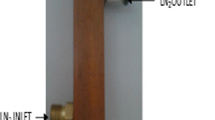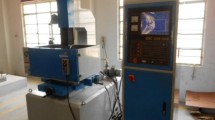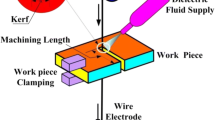Abstract
This investigation exposes electrical discharge machine (EDM) technique in expelling the metal with a conducted copper electrode from the Ti–6Al–2Sn–4Zr–2Mo alloy. The alloy Ti–6Al–2Sn–4Zr–2Mo has the highest resistance, high-temperature detection, high tensile strength, and high yield strength. Ti–6Al–2Sn–4Zr–2Mo alloy is commonly used for applications such as aerospace, medical equipment, automotive parts, and nuclear power plants. EDM provides easy machinability and excellent surface finishes. Machine parameters of primary noteworthiness, such as Discharge Current (I), Spark on time (μs), and Tool Diameter (mm), are considered using the Taguchi L27 orthogonal array. Metal removal rate (MRR), tool wear rate (TWR), and overcut (OC) perpendicularity are investigated with the help of mean effective plots. Multi response optimization to maximize the material removal rate (MRR) and minimize the tool wear rate (TWR) and over cut (OC) on the surface of the workpiece has been analyzed by Grey relational analysis (GRA). The result expresses that spark on time (Ton) contributes (6.22%) more on affecting the machining characteristics followed by electrode diameter (76.97%) and discharge current (16.97%). From the F-test, it is assumed that all the machining parameters have a significant influence on responses. Accordingly an optimum combination of machining parameters is also determined.











Similar content being viewed by others
References
F. Müller, J. Monaghan, Non-conventional machining of particle reinforced metal matrix composite. Int. J. Mach. Tools Manuf. 40(9), 1351–1366 (2000). https://doi.org/10.1016/s0890-6955(99)00121-2
D.V.S.S.S.V. Prasad, A. Gopala Krishna, Empirical modeling and optimization of wire electrical discharge machining. Int. J. Adv. Manuf. Technol. 43(9–10), 914–925 (2008). https://doi.org/10.1007/s00170-008-1769-x
A. Mohanty, G. Talla, S. Gangopadhyay, Experimental investigation and analysis of EDM characteristics of Inconel 825. Mater. Manuf. Process. 29(5), 540–549 (2014). https://doi.org/10.1080/10426914.2014.901536
D. Palanisamy, A. Devaraju, N. Manikandan, K. Balasubramanian, D. Arulkirubakaran, Experimental investigation and optimization of process parameters in EDM of aluminium metal matrix composites. Mater. Today Proc. (2019). https://doi.org/10.1016/j.matpr.2019.08.145
A.P. Dwivedi, S.K. Choudhury, Effect of tool rotation on MRR, TWR, and surface integrity of AISI-D3 steel using the rotary EDM process. Mater. Manuf. Process. 31(14), 1844–1852 (2016). https://doi.org/10.1080/10426914.2016.1140198
R. Karthikeyan, P.R. Lakshmi Narayanan, R.S. Naagarazan, Mathematical modeling for electric discharge machining of aluminum-silicon carbide particulate composite. J. Mater. Process. Technol. 87, 59–63 (1999). https://doi.org/10.1016/S0924-0136(98)00332-X
B. Mohan, A. Rajadurai, K. Satyanarayana, Effect of SiC and rotation of electrode on electric discharge machining of Al–SiC composite. J. Mater. Process. Technol. 124(3), 297–304 (2002). https://doi.org/10.1016/s0924-0136(02)00202-9
N. Singh, P.N. Raghukandan, K. Rathinasabapathi, M. Pai, Electric discharge machining of Al–10%SiCP as-cast metal matrix composites. J Mater. Process. Technol. 155–156(1–3), 1653–1657 (2004). https://doi.org/10.1016/j.jmatprotec.2004.04.321
Y.H. Guu, H. Hocheng, Effects of workpiece rotation on machinability during electrical-discharge machining. Mater. Manuf. Process. 16(1), 91–101 (2001). https://doi.org/10.1081/amp-100103699
G. Mandaloi, S. Singh, P. Kumar, K. Pal, Effect on crystalline structure of AISI M2 steel using tungsten–thorium electrode through MRR, EWR, and surface finish. Measurement 90, 74–84 (2016). https://doi.org/10.1016/j.measurement.2016.04.041
X.-P. Dang, Constrained multi-objective optimization of EDM process parameters using kriging model and particle swarm algorithm. Mater. Manuf. Process. 33(4), 397–404 (2017). https://doi.org/10.1080/10426914.2017.1292037
V.K. Meena, M.S. Azad, Grey relational analysis of micro-EDM machining of Ti–6Al–4V alloy. Mater. Manuf. Process. 27(9), 973–977 (2012). https://doi.org/10.1080/10426914.2011.610080
N. Ahmed, K. Ishfaq, M. Rafaqat, S. Pervaiz, S. Anwar, B. Salah, EDM of Ti–6Al–4V: electrode and polarity selection for minimum tool wear rate and overcut. Mater. Manuf. Process. (2019). https://doi.org/10.1080/10426914.2019.1594278
A. Kumar, A. Mandal, A.R. Dixit, A.K. Das, Performance evaluation of Al2O3 nano powder mixed dielectric for electric discharge machining of Inconel 825. Mater. Manuf. Process. 33(9), 986–995 (2017). https://doi.org/10.1080/10426914.2017.1376081
P.M. Kumar, K. Sivakumar, N. Jayakumar, Multiobjective optimization and analysis of copper–titanium diboride electrode in EDM of monel 400TM alloy. Mater. Manuf. Process. 33(13), 1429–1437 (2017). https://doi.org/10.1080/10426914.2017.1415439
R. Mukherjee, S. Chakraborty, Selection of EDM process parameters using biogeography-based optimization algorithm. Mater. Manuf. Process. 27(9), 954–962 (2012). https://doi.org/10.1080/10426914.2011.610089
R. Goyal, S. Sngh, H. Kumar, Performance evaluation of cryogenically assisted electric discharge machining (CEDM) process. Mater. Manuf. Process. 33(4), 433–443 (2017). https://doi.org/10.1080/10426914.2017.1317789
J.T. Huang, Y.S. Liao, Optimization of machining parameters of wire-EDM based on grey relational and statistical analyses. Int. J. Prod. Res. 41, 1707–1720 (2003)
K.T. Chiang, F.P. Chang, Optimization of the WEDM process of particle-reinforced material with multiple performance characteristics using grey relational analysis. J. Mater. Process. Technol. 180, 96–101 (2006)
A.N. Haq, P. Marimuthu, R. Jeyapaul, Multi response optimization of machining parameters of drilling Al/SiC metal matrix composite using grey relational analysis in the Taguchi method. Int. J. Adv. Manuf. Technol. 37(3–4), 250–255 (2007). https://doi.org/10.1007/s00170-007-0981-4
L. Selvarajan, C.S. Narayanan, R. JeyaPaul, Optimization of EDM parameters on machining Si3N4–TiN composite for improving circularity, cylindricity, and perpendicularity. Mater. Manuf. Process. 31(4), 405–412 (2015). https://doi.org/10.1080/10426914.2015.1058947
A.K. Rouniyar, P. Shandilya, Multi-objective optimization using Taguchi and grey relational analysis on machining of Ti–6Al–4V alloy by powder mixed EDM process. Mater. Today Proc. 5(11), 23779–23788 (2018). https://doi.org/10.1016/j.matpr.2018.10.169
M.S. Mhatre, S.U. Sapkal, R.S. Pawade, Electro discharge machining characteristics of Ti–6Al–4V alloy: a grey relational optimization. Proc. Mater. Sci. 5, 2014–2022 (2014). https://doi.org/10.1016/j.mspro.2014.07.534
A. Perumal, A. Azhagurajan, S. Baskaran, R. Prithivirajan, P. Narayanasamy, Statistical evaluation and performance analysis of electrical discharge machining (EDM) characteristics of hard Ti–6Al–2Sn–4Zr–2Mo alloy. Mater. Res. Express (2019). https://doi.org/10.1088/2053-1591/ab06da
Y.-C. Lin, C.-H. Cheng, B.-L. Su, L.-R. Hwang, Machining characteristics and optimization of machining parameters of SKH 57 high-speed steel using electrical-discharge machining based on Taguchi method. Mater. Manuf. Process. 21(8), 922–929 (2006). https://doi.org/10.1080/03602550600728133
Acknowledgements
The authors thankfully accept the support of the Centre for Advanced Machining, Kalasalingam Academy of Research and Education, Tamilnadu, India, for permission to utilize the services.
Funding
This project funding was not received.
Author information
Authors and Affiliations
Corresponding author
Ethics declarations
Conflict of interest
The authors declare that they have no conflict of interest.
Research Involving Human and/or Animals Participants
This chapter does not contain any studies with human participants or animals performed by any of the authors.”
Informed Consent
Additional informed consent was obtained from all individual participants for whom identifying information is included in this chapter.
Additional information
Publisher's Note
Springer Nature remains neutral with regard to jurisdictional claims in published maps and institutional affiliations.
Rights and permissions
About this article
Cite this article
Perumal, A., Azhagurajan, A., Prithivirajan, R. et al. Experimental Investigation and Optimization of Process Parameters in Ti – (6242) Alpha–Beta Alloy Using Electrical Discharge Machining. J Inorg Organomet Polym 31, 1787–1800 (2021). https://doi.org/10.1007/s10904-020-01786-1
Received:
Revised:
Accepted:
Published:
Issue Date:
DOI: https://doi.org/10.1007/s10904-020-01786-1




